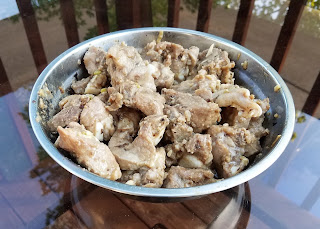Happy Hanukkah, everyone! I actually took the photos a few months ago, but hadn't written up the post until now. It seems like as good a time as any to discuss this breakfast favorite. Lox and bagels are well-known component of the Jewish-American culinary tradition. That being said, the concept of cured salmon is not new to me, though I knew it from the Scandinavian version, called gravlax. Whle the particulars of the seasoning are different, I am a fan all the same.
This particular recipe is adapted from one from a friend of Ariel's family. It's remarkably easy, and quite economical. I find the regular farm-raised salmon from Sam's Club produces excellent lox for a low price. There is one "exotic" ingredient in this recipe: liquid smoke. It's not exotic in the sense of it being hard to find, as most supermarkets carry it. However, it's a fascinating product, made from condensing water vapor produced by burning wood. I like to put a little in homemade barbecue sauce, but otherwise, I'm a novice when it comes to liquid smoke.
- 1 Salmon fillet
Per pound of salmon:
- 2 Tbs salt (non-iodized)
- 2 Tbs sugar
- A few drops liquid smoke
Rinse the salmon under cold running water and pat dry with paper towels. If your salmon has skin on it, make sure to remove the scales first. This can be done by scraping a table knife against the scales under running water.
Add liquid smoke to salt and mix well. Mix with the sugar. Rub the mixture all over the salmon, making sure to cover both sides of the fillet.
Wrap the salmon in plastic wrap and place in a gallon-size bag. You may need to fold it in half. Place in refrigerator for six days. Flip the fish over halfway through.
After the curing is done, remove from the plastic wrap and rinse thoroughly under cold running water. Pat dry. If the lox is too salty, you may need to rinse it more.
 |
| The whiskey bottle reflection in my caidao can only mean one thing: char siu! |
Slice the salmon at an angle into thin slices. A long, sharp knife is essential. My trusty Chinese caidao did the job here, but any good chef's knife works well.
The lox will keep in the refrigerator for several days, and also freezes well. Serve with bagels and cream cheese. Tomatoes are also a classic accompaniment.





























